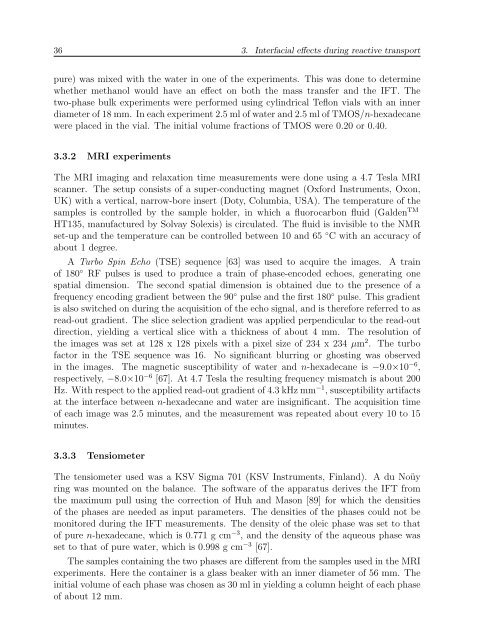Untitled - Technische Universiteit Eindhoven
Untitled - Technische Universiteit Eindhoven
Untitled - Technische Universiteit Eindhoven
- No tags were found...
You also want an ePaper? Increase the reach of your titles
YUMPU automatically turns print PDFs into web optimized ePapers that Google loves.
36 3. Interfacial effects during reactive transportpure) was mixed with the water in one of the experiments. This was done to determinewhether methanol would have an effect on both the mass transfer and the IFT. Thetwo-phase bulk experiments were performed using cylindrical Teflon vials with an innerdiameter of 18 mm. In each experiment 2.5 ml of water and 2.5 ml of TMOS/n-hexadecanewere placed in the vial. The initial volume fractions of TMOS were 0.20 or 0.40.3.3.2 MRI experimentsThe MRI imaging and relaxation time measurements were done using a 4.7 Tesla MRIscanner. The setup consists of a super-conducting magnet (Oxford Instruments, Oxon,UK) with a vertical, narrow-bore insert (Doty, Columbia, USA). The temperature of thesamples is controlled by the sample holder, in which a fluorocarbon fluid (Galden TMHT135, manufactured by Solvay Solexis) is circulated. The fluid is invisible to the NMRset-up and the temperature can be controlled between 10 and 65 ◦ C with an accuracy ofabout 1 degree.A Turbo Spin Echo (TSE) sequence [63] was used to acquire the images. A trainof 180 ◦ RF pulses is used to produce a train of phase-encoded echoes, generating onespatial dimension. The second spatial dimension is obtained due to the presence of afrequency encoding gradient between the 90 ◦ pulse and the first 180 ◦ pulse. This gradientis also switched on during the acquisition of the echo signal, and is therefore referred to asread-out gradient. The slice selection gradient was applied perpendicular to the read-outdirection, yielding a vertical slice with a thickness of about 4 mm. The resolution ofthe images was set at 128 x 128 pixels with a pixel size of 234 x 234 µm 2 . The turbofactor in the TSE sequence was 16. No significant blurring or ghosting was observedin the images. The magnetic susceptibility of water and n-hexadecane is −9.0×10 −6 ,respectively, −8.0×10 −6 [67]. At 4.7 Tesla the resulting frequency mismatch is about 200Hz. With respect to the applied read-out gradient of 4.3 kHz mm −1 , susceptibility artifactsat the interface between n-hexadecane and water are insignificant. The acquisition timeof each image was 2.5 minutes, and the measurement was repeated about every 10 to 15minutes.3.3.3 TensiometerThe tensiometer used was a KSV Sigma 701 (KSV Instruments, Finland). A du Noüyring was mounted on the balance. The software of the apparatus derives the IFT fromthe maximum pull using the correction of Huh and Mason [89] for which the densitiesof the phases are needed as input parameters. The densities of the phases could not bemonitored during the IFT measurements. The density of the oleic phase was set to thatof pure n-hexadecane, which is 0.771 g cm −3 , and the density of the aqueous phase wasset to that of pure water, which is 0.998 g cm −3 [67].The samples containing the two phases are different from the samples used in the MRIexperiments. Here the container is a glass beaker with an inner diameter of 56 mm. Theinitial volume of each phase was chosen as 30 ml in yielding a column height of each phaseof about 12 mm.
















